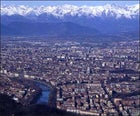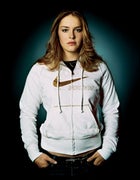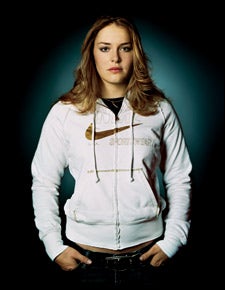1. Jeret Peterson
Torino, Tomato
No one refers to the 1960 Olympics as the Roma Games. But for 2006, the IOC has gone native, choosing Torino over Turin. This is a first—t was Munich, not Mühen; Athens, not Athína. NBC and the U.S. team have followed suit, but, for the most part, the American print media is crying bologna. While ���ϳԹ��� respects others’ rights, we’re going with Turin, too. Setting the Stage: Turin and its surroundings, site of the 2006 Winter Olympics
Setting the Stage: Turin and its surroundings, site of the 2006 Winter Olympics Lindsey Kildrow
Lindsey KildrowEn route to winning the 2005 World Cup aerials title, Jeret Peterson, 24, debuted “the hurricane,” which involves three flips and five twists—one more rotation than anyone else can land. “It’s like the four-minute mile,” he says. But with more pain. At last season’s World Championships, Peterson botched a landing and suffered a concussion, torn rotator cuff, and scratched cornea. Now fully recovered and landing more hurricanes than Florida, Peterson has his eyes set on gold: “I don’t train to get second.”
2. Shaun White
AFTER MISSING OUT on the 2002 Games by a fraction of a point, then-15-year-old Shaun White had to watch from the sidelines as Americans Ross Powers, Danny Kass, and J. J. Thomas swept the halfpipe event. But he beat all three to claim the 2003 X Games superpipe title. After missing most of 2004 with a torn meniscus, he returned last year with X Games gold on the snowboard and silver on the skateboard. “Unmatched consistency, smooth style, and big amplitude,” says Powers. “He has the whole package.”
3. Todd Hays
Todd Hays had to fight his way into bobsledding, literally. A former national-champion kickboxer, he bought his first sled with $12,000 he won at the 1995 World Freestyle Fighting Championships in Japan, then committed himself to the ice full-time. Hays, 36, piloted the silver-medal-winning four-man squad at the 2002 Games and won two World Cup races last season, both times beating the German team that edged him for gold in Salt Lake. Look for the two squads to wind up in another title fight in Turin.
4. Apolo Anton Ohno
Apolo Anton Ohno left Salt Lake City in 2002 wearing a gold and a silver, then, sadly, took them off to break-dance on MTV. Thankfully, the skater has since stuck to performing on the ice, winning the World Cup title two of the past three years and scoring two early World Cup wins this season. “He does everything he can to improve his performance,” says Derek Campbell, director of short track for U.S. speed skating. Ohno, 23, is favored to win every race he enters, which means he could be coming home with four golds.
5. Lindsey Jacobellis
The Turin Games will mark the Olympic debut of boardercross, a head-to-head—and sometimes elbow-to-head—race that sends four snowboarders at a time hurtling down a half-mile-long obstacle course. “It’s a lot like roller derby,” says Lindsey Jacobellis, 20, the sport’s biggest star. “Sometimes you have to throw a stiff arm.” She’s been throwing a lot of them. Jacobellis, who’s also a threat to medal in the halfpipe, strong-armed her way to boardercross gold at last year’s world championships, ran away with the 2005 World Cup title, and won the first World Cup event of this season.
6. Mark Grimmette & Brian Martin
What was Brian Martin, 32, doing on USA Today’s list of the 2005 top ten worst jobs in sports? Well, his sport is doubles luge, and his job is to lie underneath teammate Mark Grimmette, 34. But a podium in Turin would put the duo on the list of all-time Olympic greats. With bronze from Nagano and silver from Salt Lake, they would become the first men to medal in three straight Winter Games. And if they don’t, well, they’ll still have each other.
7. Lindsey Kildow
With a third place in last year’s World Cup super-G standings, fifth in the downhill, and sixth overall, Lindsey Kildow turned in the best season by an American woman since Picabo Street’s sixth-place finish in 1996. The one blot on her 2005 campaign was at the world championships in Bormeo, Italy, where Kildow, 21, went home empty-handed despite entering four events. “That will help her in the long run,” says two-time Olympic medalist Street. “Now she knows what it takes to win under that kind of pressure. My money’s on her to win everything.”
8. Kelly Clark
Since claiming the first gold of the 2002 Games, snowboarder Kelly Clark, 22, has only gotten better, winning two U.S. Opens, a European Open, an X Games, and a 2005 World Cup on the superpipe at Bardonecchia, Italy, where this year’s Olympic contest will be held. Besides landing McTwists at will, Clark can launch four feet higher out of the pipe than her competitors. Still, she refuses to call herself the favorite. “I’m just trying to stay focused and have fun,” she says. (Note: When she’s focused and having fun, she wins.)
9. Jeremy Bloom
After the NCAA forced him to choose between the sponsorship dollars he needed to continue as a pro moguls skier and the amateur status required to play football for the University of Colorado, where he was a wide receiver, Jeremy Bloom, 23, chose skiing. The payoff: the 2005 World Cup season title. But he’ll try out for the NFL a week after the Olympics. And should his day jobs fall through, Bloom has also lined up a gig as a host on MTV’s new high-definition channel, MHD.


